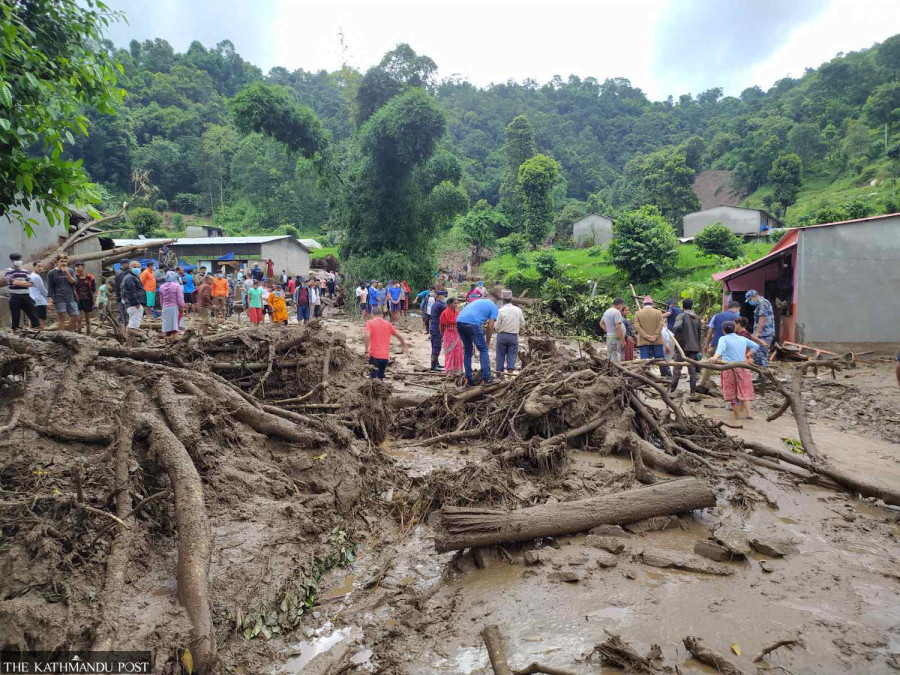Columns
Debris flow risks in homes and highways
Our rescue-centric preparedness is in place, but it’s far from effectively preventing risks.
Madhukar Upadhya
In the early hours of July 12, a massive debris flow in what was normally considered a small gully—locally called Sindure Kholsi at Simaltal on the Muglin-Narayanghat road—swept two night buses carrying a total of 62 passengers into the Trishuli River, a major tributary of Gandaki River. Although the rescue operation began immediately, two weeks of searching yielded only 24 bodies, while 35 others and the buses they were travelling in are still missing. Three of the passengers managed to swim to safety.
The government task force formed to investigate the accident submitted its report on August 6 with meticulous recommendations to avoid such mishaps on the highways in future. Meanwhile, 38 other such fatal incidents occurred by mid-July in different parts of the country, killing 76 people in their homes when debris flow buried or damaged their houses. One may ask, shouldn’t the high rate of recurrence of mudslides, debris flow and landslides prompt further investigations to understand what triggers these events so that appropriate strategies can be formulated to reduce risks in remote villages?
Heavy rains and debris flows
The Simaltal misfortune raises questions about the intensity and duration of the rainfall that night in the Sindure Kholsi watershed; according to the investigation report, some eyewitnesses observed heavy rain. Apart from the newly built rural roads, what condition was the watershed’s land in to generate such high amounts of debris? Despite the debris flow possibly lasting for quite some time, we don't have a ballpark estimate of how much.
Answers to these questions are crucial for those in other parts of the country grappling with similar problems. After all, debris or mudflows (commonly called landslides) have been one of the biggest and most recurrent threats to lives and property. It mostly occurs in and around mid-hill settlements where natural and human actions constantly alter drainage channels. The latest Solukhumbu flood, which caught global attention, reminds us that we also have infrequent yet devastating floods in higher elevations attributed to glacier lake outburst floods (GLOFs)—a different story altogether, including its trigger factor.
A cursory look at landslides across the country in 2020 shows how killer landslides have started to defy our general understanding of them. In Marang, Myagdi, the debris deposited in existing gullies during the rural road construction—similar to the one we witnessed in Simaltal this year—flowed down, causing devastation. The landslides in Barekot, Jajarkot, originated from farmlands with no road. At the same time, houses in Lidi, Sindhupalchok, were buried by debris brought down by the failure of an abandoned terrace way above the village. In Parbat and Tanahun, massive debris flow originated from some very well-guarded forest areas above the villages that killed people and damaged houses and farms. In Baglung, a combination of landslides and a series of landslide-blocked-lake-outburst floods swept away 76 houses. While comparing these places is difficult due to varied geographical conditions, one common element across all of these cases is that they were all triggered by high-intensity localised rain, a trend on the rise due to the local impacts of a changing climate yet poorly understood.
In 2021, some studies covered heavy localised rain, which deposited massive amounts of debris on the bed of the Melamchi River, rendering the intake of the Melamchi Water Supply Project impotent. Simaltal indicated a similar event on a smaller scale. Numerous incidents of such heavy localised rain across the country haven’t attracted media attention despite causing substantial and widespread damage. The investigation in Simaltal was an opportunity to dig deeper to examine the issues related to heavy localised rain, which would have provided crucial data to understand the changing nature of rainfall.
Taming the monsoon runoff
Both the monsoon disasters and water scarcity in the winter, which are worsening, are two sides of the same coin. Increasing localised rain not only leads to further disaster risks but also intense water scarcity in winter since the rainwater that is supposed to seep into aquifers won’t have enough time to do so.
The government’s rescue-centric preparedness approach has been instrumental in reducing the human toll—a commendable feat, indeed—but it’s far from effectively preventing such incidents, much less augmenting groundwater in the long run. Addressing water-induced disasters thus should take a two-pronged approach: Reduce the risks caused by heavy rain during the monsoon and find ways to augment depleting groundwater sources to ensure water security in winter. The right time to do both is during the monsoon through the management of monsoon runoff.
Except for those located on the ridge area, every village—or even farm—has its watershed from where rainwater flows down through small channels in the form of runoff. When altered, these channels get widened, deepened, or blocked by both natural and human actions and become a cause for debris flow during heavy rain. A doable solution to reduce the risk of debris flow would be to thus tame the runoff by keeping it spread over a wider area, allowing it to accumulate in ponds or converge only in stable channels that have conveyed large volumes of runoff in the past.
Revisiting past efforts
In the 1990s, some efforts were made to reinforce what people in the mountain villages traditionally did to tame the runoff and stabilise active gullies and landslides threatening farms and houses in villages in the hills of Lalitpur. It primarily involved three key actions: Appraising the landscape in and around the villages to understand the unique water problems at different elevations due to their geographical context. Then, mapping drainage channels in the watershed to look for places to divert runoff and store them temporarily in multiple dugout ponds. It would cut debris flow risks as well as augment depleting groundwater—a common concern in the hills, which is growing in recent years manifested in the drying springs and rivulets. After that, points of runoff accumulation, along with changes in the size and direction of runoff channels, would be monitored. The results were remarkable.
Active landslides and gullies stabilised and became greener—a sign of increased soil moisture—without additional investment. It’s time that lessons from these experiences be reexamined and replicated in at least those places that have begun receiving heavy localised rain to reduce the risk of debris flow and/or villages where springs and rivulets are drying up or have dried altogether.




 13.98°C Kathmandu
13.98°C Kathmandu















